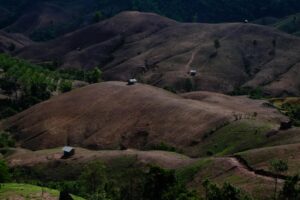Amazonian forest, Australian vegetated coasts, Californian hills, Canadian forested areas, and African green spaces – to mention a few – are highly susceptible to wildfires due to the high global temperatures that are rising yearly. This is not a phenomenon of the 21st century, and certainly not one of the last repercussions of climate change, but a rather old recurring feature of the dry season. Nevertheless, the past modern years have given rise to more all-destroying fires as the carbon emissions have increased leading to a growth in the general global temperatures.
International Mother Earth Day
A number of initiatives have been taken in order to mitigate the environmental costs of these occurrences. International Mother Earth Day has been implemented by the UN General Assembly in 2009, designating 22 April as the celebration of Mother Nature and our deep care and regard for it. This day is a powerful reminder not only to slow down and become mindful of our actions but also to acknowledge the natural beauty surrounding us. The largest humanitarian organization began its fight against climate change and started considering the planet as a central topic for debate in the 1970s when 20 million people rose up against the then-occurring environmental disasters, i.e., oil spills, smog, polluted rivers, etc. Although climate change started leaving its mark since the beginning of industrial times – i.e., the turn of the 19th century. Nevertheless, in the 1970s the UN implemented the Environment Programme. Each year the program focuses on another overarching theme, in 2021 Restore our Earth becomes the dominating maxim.
The Paris Agreement
Another initiative originated by the UN General Assembly in 2015 was the legally binding international treaty on climate change – The Paris Agreement. This treaty is laying one of the first stones in creating sustainable living for all the present and future generations. By setting the goal to limit global warming to potentially 1.5 degrees Celsius above pre-industrial levels by 2050, the UN aims at creating a ‘‘climate neutral world’’. It sets out a number of measures to be taken as a means to not only mitigate the increase in global temperature but also to adapt to the possibly unalterable consequences of climate change. The Agreement proposes that each nation will have come up with a plan by 2020 that ensures a smooth and effective change to sustainable production and consumption, thus attaining carbon neutrality targets.
While there is a path we can walk whose laws we can abide by, the implementation and initiation of such measures are progressing at a slow pace. The ‘’climate change action needs to be massively increased to achieve the goals of the Paris Agreement’’. Not only does the economic sector have to become more competitive regarding these zero-carbon solutions, but the individual also has to redirect their attention towards their own living habits.
Illegal deforestation
The largest virgin forest of Europe has become subject to deforestation. Its cause lies deep into the harrowing human conscience and is not instigated by carbon emissions. The UNESCO protected Romanian forests are being threatened by illegal logging. Around 80 million cubic meters (2.8 billion cubic feet) of wood has been illegally logged in the country over the past 20 years, resulting in a loss of EUR 5 billion (USD 5.4 billion). Many of these forest areas are being wiped out by timber traffickers and illegally sold to potentially international wood manufacturers.
These forests are a wildland comprising the most biodiverse ecological characteristics, centuries of untouched flora and fauna now victims of organized crime resulting in forest degradation. Although the European Commission made efforts to take legal action against Romanian authorities over their systemic and continuous failure to stop the illegal forestry practices, the Romanian local authorities have not responded. Acts like these only prove how hard it is for individuals to prioritize the fight against climate change and how financial gains are still occupying the minds of those ignorant to the environmental issues that will ultimately take a spin and impact even those who initiated them.

Image by Boudewijn Huysmans on Unsplash
The Amazonian forest is also facing troublesome times as deforestation is still a central topic to the population. Around 20% of the initial forest has been cleared out in order to make room for agriculture and animal husbandry. The Amazon is an unending well of biodiversity managing to store up to around ‘‘five years worth of human-made carbon emissions’’. Without these green CO2-absorbing lungs the global temperatures would face an even more staggering increase.
Trees are our strongest defenses
Why are people so centered around preserving virgin and natural forests? As familiar as it might sound, they are (among) the last reserves we have in our arsenal in combating the effects produced by greenhouse gases. Particularly rainforests are ideal for carbon concentration as they suck up the largest quantities of CO2 from the air and use them to produce biomass and convert it to oxygen through photosynthesis. However, the degradation of forests results in a decrease in carbon storage, and most effectively these gases are released once more into the atmosphere when the trees are cut down.
Carbon sink forests are those that can store more carbon than is released through land-use change and deforestation. The Amazon is considered a carbon sink, yet a recent study predicts that this pristine forest will turn into a carbon source in the next decades. The same trend applies to the Madagascar forests, the world’s oldest island, which has already undergone this change as it has lost nearly 90% of its natural forests in four decades. Now Madagascar is considered a carbon source instead of a carbon sink.
Yet there is hope! Inspirational projects have been set up around the world whether by grassroot activists or large-scale organizations that act upon the sustainability goals of the Paris Accord.
The Great Green Wall
The Great Green Wall is an African-led campaign, one of the greatest anti-climate-change initiatives, aimed at planting an 8,000 km forest across North Africa, the Sahel, and the Horn, i.e., the southern part of the Sahara desert, one of the poorest regions on Earth. This movement functions as an international call to action, a flag-waving stance taken against the devastating effects of climate change.
The Wall ensures not only an alternative to desertification and droughts that affect food supply but also provides local jobs, lowering the probability of migration and conflict. The plan which started in 2007 by the African Union has succeeded to cover 15% of the initial region. It was supported by numerous local communities, research institutes, and international organizations. Ultimately, this act also stands up for inclusion, acceptance, and union across African countries that now engage in a communal movement.
Reverse-engineering the rainforest
Another inspiring initiative takes place in the Amazon forest where ‘‘the largest tropical reforestation project in history has begun’’. This movement seeks to replant 73 million new trees on 70,000 acres (about 35,000 soccer football pitches ) of land over the next six years. Initiated by the Conservation International NGO, this project is based on new reforestation techniques.
These include the collection of various tropical tree seeds from the Xingu Seed Network, which is composed of indigenous women and local youth from across 19 municipalities of the Xingu’s watershed who collect seeds from the native Brazil nut, rubber, and mahogany trees, among others. To ensure a high probability of success, the ‘‘muvuca’’ approach is used – ‘’a direct-seeding method in which seeds from more than 200 native forest species are spread over every square meter of burnt, mismanaged or deforested land’’.
This is different from the average forest replantation where identical saplings are planted individually. To keep encouraging locals to take part in this project, around $700 is delivered to each family for every forested acre. The initiative also ensures to continue working as a natural habitat for about 40,000 species of plants, over 400 mammals including sloths, armadillos, and jaguars, and about 1,300 kinds of birds and millions of insects.
The power lies in our hands
These planet rehabilitation plans sound encouraging and uplifting. Yet, there is still a long way to go before we can reach the carbon neutrality goals. If we do not succeed in bringing a halt to the increase in the average global temperatures or stabilize the exponential trend, then we will find ourselves at risk of becoming the ultimate most threatened victims of this phenomenon.
It is imperative to not only direct our emergency call to the average individuals who can affect climate change but to begin addressing the global corporations who cause 71% of our Greenhouse gas emissions. It also comes to us as private individuals to affect their production techniques through our consumption and lifestyle. Whether that implies education, signing petitions, organizing large protest gatherings, or hands-on action by investigating and exposing the culprits of these wrongdoings.
Let us not stay passive before the storm and wait for its repercussions to strike back, robbing us of our most essential needs, but take action and help in protecting our planet – let us protect our home!
Header Image by Miriam Espacio on Unsplash


